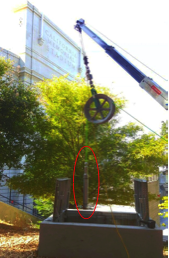4
A key element to understanding and classifying the behavior of an earthquake fault is to monitor its seismic activity. The BSL operates several extensive networks of seismometers in Northern California. One of these networks covers the Hayward Fault. Currently, you are standing in front of one of the most important components of this network, where a seismometer is sunk into a borehole, which penetrates directly into the active fault. This borehole is almost 600 ft deep, which its bottom is about 150 ft below sea level. The seismometer is one of the few seismic sensors in the world deployed directly into an active fault. The station is named “CMSB” after the California Memorial Stadium.
Typically seismometers are placed in small concrete vaults directly on or at a maximum of a few feet below the ground. There are however special seismometers which can be placed deep into water filled boreholes. They are of a slim, cylindrical design capable of withstanding several thousand pounds of water pressure. The latest seismometer sunk into this borehole is shown inside the red ellipse in figure 4.1 during its deployment in August 2016.

There are two reasons why seismologists deploy seismometers in deep boreholes. At depth the seismic noise (ground vibrations) generated by the footsteps of thousands of football fans or by cars and trucks driving by is greatly reduced, which makes for clearer recordings of even the smallest earthquakes (see figure 4.3). A deep deployment also brings the seismometer closer to the earthquake sources, which further increases its detection capability.
Like any other seismometer, such borehole sensors can be overwhelmed, when a strong earthquake occurs close by. They clip and the data they collect become useless to seismologists. In order to still be able to “catch” strong local earthquakes, BSL engineers have placed an additional sensor into the concrete vault built around the wellhead of the borehole. Such accelerometers (see figure 4.2) are also called strong motion sensors, because they are designed to record strong earthquakes with a high fidelity.
Together, the highly sensitive borehole sensor and the accelerometer at the surface are able to record the full spectrum of the earthquakes which are expected in the Berkeley section of the Hayward Fault.

An example of a recording of a very small earthquake is shown in figure 4.3. The epicenter of this quake with a magnitude of 1 was about 900 yards north of the borehole at the westernmost edge of the Lawrence Berkeley National Laboratory. The quake occurred on the Hayward Fault at a depth of more than 5 miles.

